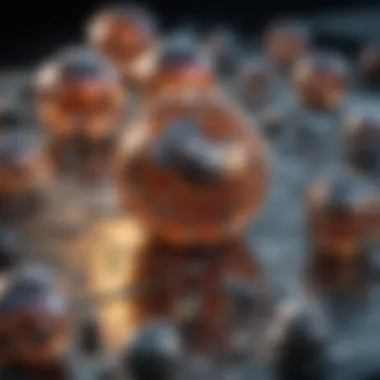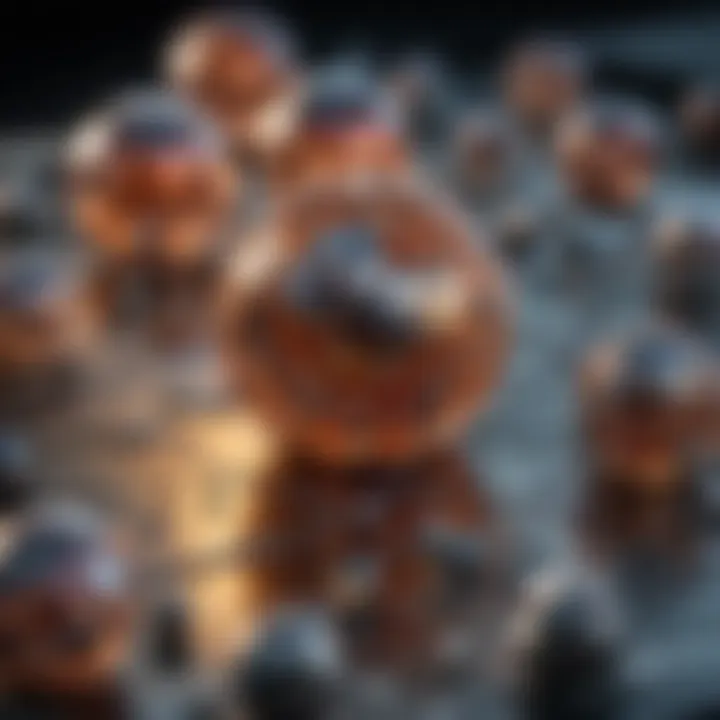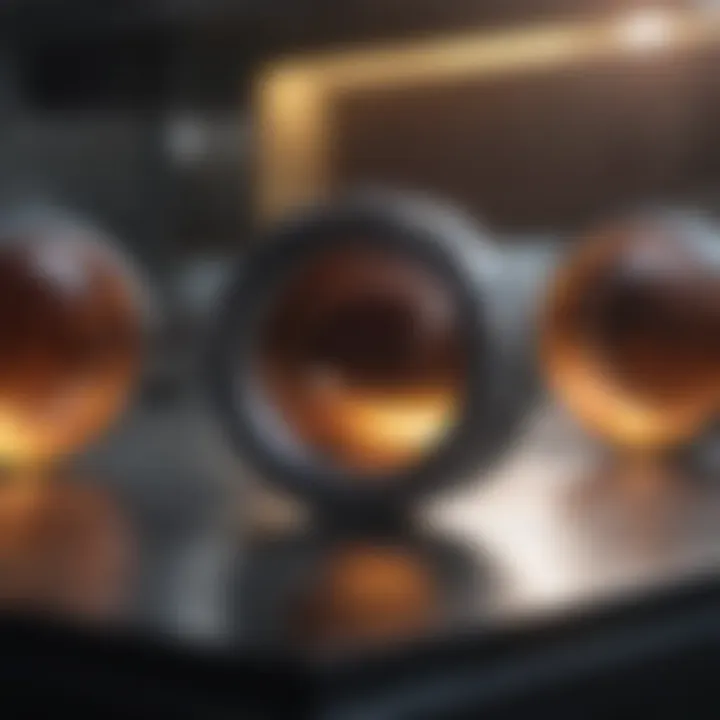In-Depth Exploration of Amorphous Metallic Alloys


Intro
Amorphous metallic alloys, often referred to as metallic glasses, represent a unique category of materials characterized by their disordered atomic structures. Unlike crystalline metals, which have a long-range ordered arrangement of atoms, amorphous alloys lack such organization. This structural difference endows them with distinctive properties that have shown potential across various applications.
The study of these alloys has gained momentum in recent decades, fueled by advancements in production techniques and a deeper understanding of their properties. Engineered to overcome some of the limitations of conventional materials, these alloys are now being utilized in sectors ranging from electronics to biomedical applications. This article aims to provide a rigorous exploration of amorphous metallic alloys, analyzing their properties, production methods, and real-world applications.
Background and Context
Overview of the research topic
The exploration of amorphous metallic alloys is significant for both scientific and practical reasons. Their ability to combine the benefits of metals, such as conductivity and strength, with the advantageous attributes of glasses, such as resistance to crystallization, positions them as ideal candidates for innovative material solutions. The ongoing research into these materials seeks to unlock new performance metrics and broaden their use across industries.
Historical significance
The concept of metallic glasses emerged in the 1960s, primarily credited to the groundbreaking work by researchers like William J. Kroll and colleagues. The initial discovery set the stage for numerous studies that continued to unveil the potential of these materials. Over the decades, notable advancements in production techniques, particularly through rapid cooling methods like splat quenching, have allowed for the creation of stable amorphous alloys. These processes led to discoveries about their physical properties, such as enhanced strength and unique magnetic characteristics.
The historical context underscores the importance of continuous research and development as industries seek to leverage the unique properties of amorphous metallic alloys for future applications.
Key Findings and Discussion
Major results of the study
Recent studies have highlighted several key findings related to amorphous metallic alloys. Some notable properties include:
- High strength: Amorphous alloys can exhibit tensile strengths greater than conventional crystalline metals.
- Corrosion resistance: Many amorphous alloys display superior resistance to environmental factors, making them suitable for harsh environments.
- Magnetic properties: Certain alloys have shown promising magnetic characteristics, leading to potential applications in electronics and energy storage.
- Flexibility in design: Their unique formation allows for tailoring properties by adjusting composition and manufacturing methods.
Detailed analysis of findings
A detailed analysis reveals that the alloying elements and cooling rates during production significantly affect the properties of amorphous metallic alloys. Binary and ternary systems, such as those composed of nickel, titanium, and zirconium, have been extensively studied.
One interesting observation is the relationship between specific alloy compositions and their thermal stability. Increasing the content of elements like titanium typically enhances the structural integrity of these materials under heat, thus expanding their practical usability. Additionally, as research progresses, understanding the underlying atomic dynamics continues to be a focus, helping to elucidate why certain compositions perform better than others.
Prelude to Amorphous Metallic Alloys
Amorphous metallic alloys represent a significant area of study within materials science. Understanding these materials is crucial due to their unique properties and increasing applications in advanced technology sectors. This article explores their characteristics, production processes, and the implications of their use. The relevance of this topic spans various fields, from electronics to biomedical applications, making it integral for students, researchers, educators, and professionals alike.
Definition of Amorphous Metallic Alloys
Amorphous metallic alloys, often referred to as metallic glasses, are non-crystalline materials that lack a long-range atomic order. Unlike traditional crystalline alloys, which have regularly arranged atoms, the atomic structure of amorphous alloys is disordered. This unique arrangement confers distinct physical and chemical properties, such as high strength, elasticity, and resistance to corrosion. The composition of these alloys typically includes elements such as iron, cobalt, nickel, and various metalloids, and can vary widely to optimize specific characteristics.
Historical Context and Development
The discovery of amorphous metallic alloys dates back to the 1960s. Pioneering research was conducted by scientists like William Klement, who explored the cooling rates necessary to create amorphous structures in metals. Early applications were limited, but advancements in production methods have considerably extended their usability. The invention of rapid solidification techniques, especially in the 1980s, marked a turning point for these materials. With increased research funding and interest, today’s market sees a growing range of applications. Producing amorphous alloys has shifted from laboratory curiosities to practical solutions, underscoring the importance of ongoing research in this area.
In summary, the development and understanding of amorphous metallic alloys have evolved significantly over the past few decades, making them a focal point in materials science.
Fundamental Properties
Understanding the fundamental properties of amorphous metallic alloys is crucial for comprehending their behavior and applications. These properties include mechanical, thermal, and magnetic characteristics, each having specific implications on the performance and adaptability of these materials in various industries. The unique arrangement of atoms in amorphous alloys leads to distinct advantages and some limitations that researchers and engineers must consider when selecting these materials for different uses.
Mechanical Characteristics
Mechanical characteristics of amorphous metallic alloys are vital in determining their suitability for structural applications. These characteristics largely include strength, hardness, elasticity, and ductility.
Strength and Hardness
Strength and hardness are essential mechanical properties for many applications. Amorphous metallic alloys often exhibit significantly higher strength compared to crystalline counterparts. This increased strength is due to the lack of grain boundaries that can act as failure points in traditional metals. The key characteristic here is the high yield strength, which can make these alloys particularly attractive for applications requiring durability under stress.
However, while hardness contributes to wear resistance, it may also create brittleness, which can be a disadvantage if the component needs to undergo deformation. The trade-off between strength and brittleness is an important aspect to consider in the design of parts that will experience dynamic loads.
Elasticity and Ductility
Elasticity and ductility are crucial for predicting how materials will respond under various conditions. Amorphous alloys typically display unique elastic properties, maintaining their shape without permanent deformation when under stress. This makes them useful in applications where flexibility is important.
On the other hand, ductility can sometimes be limited in amorphous alloys. While some compositions may allow for some degree of deformation without breaking, many amorphous alloys do not exhibit the same level of ductility as traditional metallic alloys. Therefore, understanding the balance of these properties is vital when selecting materials for specific applications.
Thermal Properties


Another important aspect of these materials includes their thermal properties, which encompass glass transition temperature and thermal conductivity. These properties are significant for their practical applications in environments with extreme temperatures.
Glass Transition Temperature
The glass transition temperature (Tg) defines the point where the amorphous structure transitions from a hard and relatively brittle state into a more rubber-like state. This characteristic is crucial for applications where temperature fluctuations are present. High Tg values enable materials to maintain their properties in elevated temperature environments, enhancing their usability in electronics and aerospace industries.
Conversely, if a material has too low a Tg, it may not perform well under heat, risking structural integrity. Therefore, selecting alloys with appropriate Tg is pivotal based on intended use.
Thermal Conductivity
Thermal conductivity in amorphous metallic alloys is another property that influences their applications. While these alloys often have lower thermal conductivity than their crystalline counterparts, this can be beneficial in situations requiring insulation or resistance to heat flow. The low thermal conductivity is particularly valuable in electronics where heat dissipation is critical.
Yet, this thermal property can limit their effectiveness in certain applications where high thermal conductivity is desired. Hence, it is essential to balance these requirements based on the final use case.
Magnetic Properties
Magnetic properties play a significant role in the application of amorphous metallic alloys, especially in electronics and storage applications. Key aspects of interest are ferromagnetism and magnetic permeability.
Ferromagnetism
Ferromagnetism in amorphous metallic alloys contributes to their functionality in magnetic applications. Having a high saturation magnetization makes these materials suitable for transformers and magnetic sensors, allowing for efficient performance in energy applications and signal processing.
However, controlling the ferromagnetic properties can be challenging, particularly in ensuring stability over time. While advantageous, this requires careful material design to harness these properties effectively in practical applications.
Magnetic Permeability
Magnetic permeability refers to how easily a material can become magnetized. Amorphous alloys often possess high permeability, facilitating their use in low loss magnetic components. This characteristic is beneficial for applications in inductors and transformers, where efficiency is vital.
Nonetheless, magnetic permeability can vary with different compositional changes, indicating the necessity of research and development to optimize these materials for specific needs.
Understanding the fundamental properties of amorphous metallic alloys reveals their potential and limitations, informing better material selection for targeted applications.
Formation and Structure
The study of formation and structure is crucial for understanding amorphous metallic alloys. These materials do not have a long-range ordered structure like crystalline metals. Instead, their atoms are arranged in a disordered fashion. This characteristic impacts many properties, including strength, corrosion resistance, and thermal stability. Knowing how these alloys are formed and structured is essential for enhancing their applications in various industries. Materials scientists and engineers can design better alloys with optimized properties by exploring production techniques and atomic arrangements.
Production Techniques
Production techniques define how amorphous metallic alloys are created, significantly influencing their properties and applications. The primary methods include rapid solidification and physical vapor deposition.
Rapid Solidification
Rapid solidification is a key production technique for amorphous metallic alloys. This process involves cooling the molten metal at high rates, often exceeding 1,000 degrees Celsius per second. One of the significant aspects of rapid solidification is its ability to suppress crystallization. This characteristic makes it a popular choice for creating amorphous alloys.
The unique feature of rapid solidification is its high cooling rates, which effectively prevent atoms from arranging into a crystalline structure. The advantages of this method are its relatively low production costs and its effectiveness in producing bulk amorphous alloys. Such alloys can display superior mechanical properties compared to their crystalline counterparts, making rapid solidification an efficient choice. However, the technique can also require complex equipment and careful control of processing conditions, which could influence production scale.
Physical Vapor Deposition
Physical vapor deposition (PVD) is another significant technique for producing amorphous metallic alloys. PVD involves the evaporation of a material in a vacuum and its subsequent condensation onto a substrate. This method allows for precise control over composition and film thickness.
A key characteristic of physical vapor deposition is its versatility; it can be used to create thin films of various metallic alloys. This is beneficial for applications in electronics and coatings due to its ability to form uniform coatings on complex shapes. Unique to PVD is its ability to produce high-purity materials, which is vital for improving the performance of alloys in functional applications. However, the disadvantages include potentially higher costs and slower production rates compared to rapid solidification.
Atomic Arrangement
The atomic arrangement in amorphous metallic alloys is a topic of high relevance concerning their overall properties and performance. It differs fundamentally from that in crystalline structures, which has significant implications for material behavior.
Comparison to Crystalline Structures
The comparison to crystalline structures reveals essential differences in how atoms are arranged in these two types of materials. In crystalline structures, atoms are organized in a periodic pattern, giving rise to unique mechanical and thermal properties. On the other hand, amorphous metallic alloys lack this long-range order, leading to increased isotropy in properties like strength and ductility. This isotropy can be advantageous in certain applications, where uniform performance is desirable.
One unique feature of amorphous alloys is their resistance to crack propagation due to the absence of grain boundaries found in crystalline materials. This characteristic contributes to their improved toughness and reliability in various applications. However, the lack of a defined structure can also lead to challenges, such as finding suitable processing techniques to maintain the desired properties.
Influence of Composition on Structure
The influence of composition on structure plays a significant role in determining the properties of amorphous metallic alloys. Different alloying elements can affect the arrangement of atoms and, consequently, the mechanical and thermal behaviors of the resulting materials.
A critical characteristic of composition's influence is its ability to tailor properties for specific applications. By adjusting the ratios of metal elements, scientists can create alloys with desired attributes, such as increased hardness or improved corrosion resistance. A unique feature of this composition-dependent behavior is the tunability of properties based on variations in atomic size and bonding characteristics. While such flexibility is advantageous, it also demands a deep understanding of phase diagrams and thermodynamic principles to avoid undesirable outcomes during production.
Applications in Industry


Amorphous metallic alloys have revolutionized various industries due to their unique properties and capabilities. These materials offer advantages that traditional alloys often cannot match. Applications in industry range from electronics to aerospace, emphasizing the importance of amorphous alloys in advancing technology and efficiency.
Electronics and Magnetic Devices
Transformers and Inductors
Transformers and inductors play a crucial role in the electrical engineering sector. Amorphous metallic alloys enhance the efficiency and performance of these devices. The key characteristic of these amorphous alloys is their high magnetic permeability, which leads to reduced energy losses during operation. This makes them a beneficial choice for designing more compact and efficient transformers.
A unique feature of transformers using amorphous alloys is their ability to operate at lower energy levels without compromising performance. This results in significant savings in energy consumption and operational costs. However, the production of these alloys can be more challenging compared to traditional materials.
Magnetic Sensors
Magnetic sensors are essential in various applications, including automotive, consumer electronics, and industrial automation. The use of amorphous metallic alloys in these sensors brings notable benefits. Their high sensitivity to magnetic fields allows for precise measurements and reliable performance. This key characteristic contributes to the overall functionality of the devices in which they are used.
A unique feature of magnetic sensors utilizing these alloys is their ability to function effectively in harsh environmental conditions. This durability makes them suitable for a wide range of applications. While the cost of production for these sensors may be higher, the long-term benefits often outweigh the initial investment.
Aerospace and Automotive
High-Strength Components
In aerospace and automotive industries, high-strength components are vital for ensuring safety and reliability. Amorphous metallic alloys are increasingly used in this domain due to their exceptional mechanical properties. The key characteristic is their combination of strength and lightweight nature, allowing for the creation of highly durable components without adding excessive weight.
A unique feature of these high-strength components is their resistance to fatigue and wear, making them ideal for critical applications like engine parts and structural components. This can lead to longer lifespan and lower maintenance costs. However, the high production costs remain a consideration for manufacturers.
Corrosion Resistance
Corrosion resistance is another critical aspect of materials used in aerospace and automotive applications. Amorphous metallic alloys possess excellent corrosion resistance compared to traditional metal alloys. This property is vital for components exposed to extreme environments, as it prevents degradation over time.
The unique feature of these alloys lies in their ability to maintain structural integrity despite exposure to corrosive substances. This results in enhanced durability and reliability of components. Nevertheless, the manufacturing processes for these materials can be complex and expensive, which may deter some manufacturers from adopting them.
Biomedical Applications
Prosthetic Devices
Prosthetic devices benefit significantly from the use of amorphous metallic alloys. These materials provide a favorable combination of strength, flexibility, and lightweight properties. The key characteristic of these alloys allows for the production of more comfortable and functional prosthetics that can adapt to the user’s movements.
A unique feature of prosthetic devices made from amorphous alloys is their biocompatibility, which is essential in biomedical applications. This reduces the risk of adverse reactions in patients. However, the cost of manufacturing such devices can be high, posing challenges in accessibility.
Biomedical Implants
Biomedical implants are crucial in modern medicine, and the use of amorphous metallic alloys is gaining traction in this field. These alloys exhibit excellent mechanical properties and corrosion resistance, making them suitable for long-term implantation. The key characteristic here is their ability to withstand body conditions while providing support or replacement to damaged tissues.
A unique feature of implants made from these alloys is their customizable properties, which can be tailored for specific applications. While the research into these materials continues, the challenges of manufacturing and regulatory approval can slow down their widespread adoption.
Comparative Analysis
The comparative analysis of amorphous metallic alloys against other materials is vital for understanding their role and potential in modern applications. This section aims to highlight facets that distinguish these alloys from traditional metal alloys and organic materials. Different characteristics like performance, cost, and environmental impact come into focus here. Understanding these aspects offers insights necessary for material selection in various industries.
Versus Traditional Metal Alloys
Advantages and Disadvantages
When contrasting amorphous metallic alloys with traditional metal alloys, several advantages arise. Amorphous alloys often exhibit superior strength and hardness, which makes them appealing for applications demanding high durability. Their non-crystalline structure leads to improved wear resistance and a lower likelihood of fatigue under stress. However, one must consider the disadvantages, such as brittleness in some cases.
An essential characteristic of traditional alloys is their well-understood mechanical properties. These properties are often predictable because of extensive historical knowledge and data. This predictability supports the reliability of traditional alloys in established applications. Therefore, for industries requiring proven material performance, traditional metal alloys might be favored despite their limitations on certain properties compared to amorphous alloys.
Cost-Effectiveness
Cost-effectiveness is another focal point when evaluating amorphous metallic alloys against traditional counterparts. While amorphous alloys can be produced with state-of-the-art techniques, which may incur higher upfront costs, their long-term advantages can compensate for this. For instance, the longer lifespan and less frequent need for replacement reduce overall lifecycle costs.
Furthermore, the unique production methods of amorphous alloys, like rapid solidification, can lead to material efficiencies. The initial investment can be offset by lower operating costs in applications such as electronics, where energy efficiency is critical. Despite their upfront costs being potentially higher, companies must assess both initial and operational expenses in their comparative analyses.
Versus Organic Materials
Performance Metrics
Amorphous metallic alloys generally surpass organic materials in various performance metrics. For example, their mechanical strengths, such as hardness and flexibility, outperform many polymers and organic composites, making them a preferred choice for components needing high performance. Amorphous alloys resist deformation better than organic materials, particularly in extreme environments where durability is essential.
A unique feature of these alloys is their thermal stability compared to organic materials. Organic materials can lose integrity under heat, whereas amorphous alloys maintain structure and functionality at elevated temperatures. This property ensures reliability in applications subjected to varying conditions, which organic materials may not withstand.


Environmental Considerations
In terms of environmental considerations, amorphous metallic alloys offer distinct advantages over organic materials. Typically, amorphous alloys do not leech harmful substances, making them safer in various settings. Also, the production of amorphous alloys can be geared more towards recyclability than some organic materials, which may only contribute to waste.
However, it is crucial to consider the resource extraction and energy consumption involved in producing amorphous alloys. While they may present fewer end-of-life environmental issues compared to organic options, the manufacturing process can be energy-intensive. Balancing these factors will significantly influence future material choices as sustainability becomes a growing concern.
Overall, the comparative analysis of amorphous metallic alloys against traditional metal alloys and organic materials emphasizes essential qualities like performance, cost, and environmental impact. These comparisons enable industries to make informed decisions in material choices for diverse applications.
Research Trends and Innovations
Research into amorphous metallic alloys is evolving rapidly, driven by advancements in materials science and technology. These new explorations are crucial as they shape future applications and enhance existing technologies. Understanding these trends help researchers, engineers, and academics to align their studies with market needs and technological developments.
Ongoing research focuses on enhancing the desirable properties of these alloys while addressing the challenges present in their fabrication and application. This section delves into specific recent scientific advances, as well as the intrigue of future directions in research, making a significant contribution to the reader’s understanding of this material's full potential.
Recent Scientific Advances
Novel Composition Discoveries
Recent studies have brought forward exciting thrusts in novel composition discoveries of amorphous metallic alloys. These newfound compositions often exhibit improved properties that are attractive for usage across diverse sectors. One particular characteristic is the ability to customize the alloy's chemical makeup to enhance its mechanical strengths or other traits. This flexibility promotes a vibrant exploration of materials tailored for specific applications.
Among various compositions, alloys incorporating elements like zirconium, titanium, and various rare earth metals showcase notable improvements in hardness and corrosion resistance. These choices are popular because they allow for more versatile applications in fields ranging from aerospace to biomedical devices.
The unique feature of exploring these compositions lies in their tunability. This adaptation offers advantages such as optimizing performance metrics while also sometimes posing challenges related to production scales or costs.
Enhanced Manufacturing Techniques
Advancements in manufacturing techniques are also pivotal in realizing the full potential of amorphous metallic alloys. Enhanced processes such as advanced rapid solidification and metallic glass manufacturing techniques have significantly increased efficiency and material performance. These methods allow for better control over the cooling rates during production, leading to improved properties such as toughness and flexibility.
A notable characteristic is the ability to create amorphous structures at larger scales than previously thought possible. This aspect has made these techniques a favorable choice for researchers and manufacturers alike, broadening the viability of amorphous alloys in industrial applications.
However, the unique challenge is ensuring consistent quality across larger batches. The cost versus the intrinsic benefits often needs careful consideration, which can influence the decision-making process in industrial settings.
Future Directions in Research
With a foundation firmly laid, the exploration of future directions for amorphous metallic alloys holds great intrigue. The innovation landscape is set to expand, focusing not just on the materials but also on their integration with evolving technologies and sustainability.
Integration with Smart Technologies
One potential direction is the integration of amorphous metallic alloys with smart technologies. This merges materials science with artificial intelligence and IoT systems, paving the way for smart materials that respond adaptively to environmental stimuli. This integration enables them to be programmed for specific functions, enhancing their utility in various applications.
The key characteristic of this line of research is the dynamic response feature. By tailoring the alloys with embedded sensors, they can provide real-time feedback based on environmental changes. This feature is advantageous because it opens new pathways for applications in robotics, wearable technology, and smart infrastructures.
Nevertheless, this integration may raise concerns related to complexity and the reliability of the materials under operational conditions, which encourages continued research and development.
Potential for Sustainable Materials
Beyond immediate applications, there is a significant focus on the potential for sustainable materials. Research trends are steering towards developing alloys that minimize environmental impact while maintaining performance standards. This involves focusing on recyclable materials and reducing waste during the production process.
The key characteristic making this avenue appealing is the global push towards sustainability. As businesses and consumers become more environmentally conscious, materials that fit these criteria are favored. The unique advantage of pursuing sustainable alternatives is the potential for broader market acceptance, aligning with corporate sustainability goals.
However, the challenge remains to ensure that sustainable materials offer competitive performance to their non-sustainable counterparts. Balancing these factors is critical for future innovation in the field.
"Innovation in amorphous alloys is not just about pushing boundaries; it's about shaping the future of material science for a sustainable world."
This overview of research trends and innovations provides a compelling glimpse into the dynamics of amorphous metallic alloys, highlighting both current advancements and future pathways. By engaging with these subjects, professionals and scholars can remain informed and proactive in their respective fields.
Finale
In the realm of materials science, amorphous metallic alloys play a significant role due to their unique properties and wide range of applications. The conclusion of this analysis encapsulates the key insights derived from the exploration of these materials. The comprehensive nature of this article allows readers to appreciate not only the scientific underpinnings of amorphous metals but also their implications in various industries.
Summary of Key Insights
Amorphous metallic alloys exhibit distinct characteristics that set them apart from their crystalline counterparts. These include superior strength, excellent corrosion resistance, and unique magnetic properties. The production methods, such as rapid solidification, have shown to dramatically influence the atomic arrangement, which in turn affects the performance of the materials. Key insights include:
- Their potential use in developing high-performance components in electronics and automotive sectors.
- An understanding of how composition variations influence properties, enabling tailored applications in real-world settings.
- Recognition of the cost-effectiveness compared to traditional alloys, making them sustainable alternatives in many applications.
The Future of Amorphous Metallic Alloys
Looking forward, the future of amorphous metallic alloys appears promising. Ongoing research trends highlight innovations in production techniques and novel compositions. The integration of smart technologies into materials science will likely facilitate enhanced capabilities, such as self-healing properties and adaptability under various conditions.
Important considerations include:
- The potential adoption of these materials in sustainable manufacturing processes, reducing waste and energy consumption.
- The exploration of biocompatibility for biomedical applications, where the unique properties of amorphous alloys can lead to revolutionary advancements in prosthetics and implants.
In summary, the exploration into amorphous metallic alloys not only unveils their distinct properties but also emphasizes their growing relevance in modern technology and industry. As research continues, the evolution of these materials promises to redefine their applications and solidify their place in future advancements in materials science.







